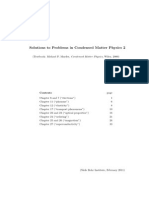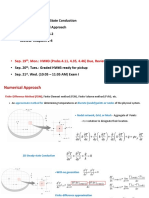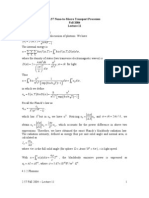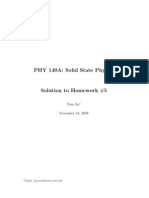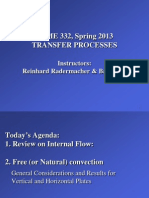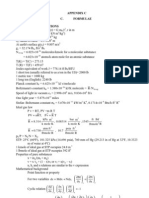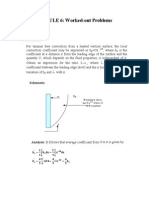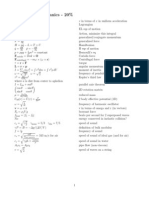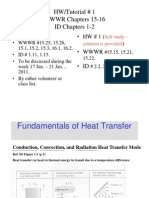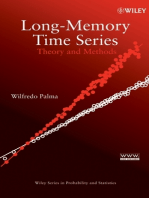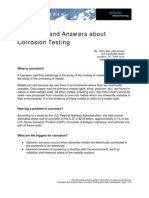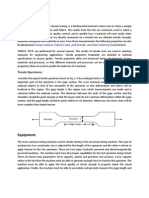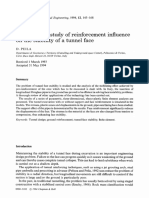Chapter Five Phonons II. Thermal Properties
Chapter Five Phonons II. Thermal Properties
Uploaded by
Penny YapCopyright:
Available Formats
Chapter Five Phonons II. Thermal Properties
Chapter Five Phonons II. Thermal Properties
Uploaded by
Penny YapOriginal Description:
Original Title
Copyright
Available Formats
Share this document
Did you find this document useful?
Is this content inappropriate?
Copyright:
Available Formats
Chapter Five Phonons II. Thermal Properties
Chapter Five Phonons II. Thermal Properties
Uploaded by
Penny YapCopyright:
Available Formats
1
Chapter Five Phonons II. Thermal Properties
Phonons : dominate thermal properties of materials and affect the
electrical transports of conductors by scatterings of electrons
Phonon generations : How are phonons created or excited in a crystal?
External perturbations vibrations or sound transducer
Scattering of particles energy transferred into lattice vibrations
Thermal (K
B
T) excited at any finite temperature (T0K)
Thermal phonons : consider a system with energy level E
n
E
n
E
n-3
E
n-1
Probability of occupancy
at temperature T
Boltzmann factor
|
|
.
|
\
|
T k
E
exp ) P(E
B
n
n
2
Excitation level amplitude (n) w/. energy
, k mode
r
( )
( )
( )
( ) T k
x where
sx exp
sx exp
dx
d
T k
1/2) (s
exp
T k
1/2) (s
exp s
T k
E
exp
T k
E
exp s
E P
E P s
n
B
s
s
s
B
s
B
s
B
s
s
B
s
s
s
s
s
h
h
h
=
=
|
|
.
|
\
|
+
|
|
.
|
\
|
+
=
|
|
.
|
\
|
|
|
.
|
\
|
= =
Planck distribution of < n(, T) >
average # of phonons excited
per mode at
1
T k
exp
1
T) , n(
B
(
=
h
2
1
n h
|
.
|
\
|
+
Average of phonons
3
0.0 0.5 1.0 1.5 2.0 2.5 3.0 3.5 4.0
0.0
0.5
1.0
1.5
2.0
2.5
3.0
3.5
4.0
<
n
(
,
T
)
>
x
-1
= k
B
T / h
High T ( k
B
T >> h )
< n(, T) > ~
Low T ( k
B
T < h )
< n(, T) > ~
1
T k
exp
) D( d
) n( ) D( d
n U
B
i
mode
i
i
|
|
.
|
\
|
=
=
=
h
h
h
h
Thermal energy
thermal equilibrium
density of modes
h
T k
B
|
.
|
\
|
h
T k
exp
B
4
Density of states (modes) : uniform in k-space
1D D(k)density of states = number of states per unit k at k
D(k)dk number of states from k to k+dk
A linear chain of length L carries N+1 particles with separation a.
Boundary condition : u
0
(t)=0 and u
N
(t)=0 fixed points
s=0
s=N
L
1) - (N
... ,
L
4
,
L
3
,
L
2
,
L
No motion at all.
L
a sN
.
|
\
|
u
s
(t)=u exp[-i
k,p
t] sin(ska) where k=
Why is there no N/L for allowed k? u
s
(t) =0
( ) s sin sin =
|
L
k =
One mode for each interval
>
=
a
k for 0
a
k for
L
D(k)
The number of modes per unit range of k
5
Unbounded medium but w/. periodic solution over the distance L
Periodic boundary conditions u(sa)=u(sa+L) for a large system
u
s
(t)=u exp[ i(ska-
k,p
t) ] where k=
... ,
L
6
,
L
4
,
L
2
, 0
L
2
k = One mode for each interval
otherwise 0
a
k
a
for
2
L
D(k)
=
=
The number of modes per unit range of k
d
d
dk
D(k) 2 D(k)dk 2 )d D(
k of for 2 and dk
2
L
D(k)dk
= =
=
The number of modes per unit frequency range
g
v
2D(k)
/dk d
2D(k)
d
dk
D(k) 2 ) D( = = =
Singularity at v
g
=0, determined by (k)
Dispersion relation
6
One dimensional monatomic lattice
( )
2 2
max
2
max
C
M
N
2
ka
cos
2
a
M
4C
Na/2 2
/dk d
2D(k)
) D(
2
ka
sin
M
4C
=
|
.
|
\
|
= =
|
.
|
\
|
=
D()
k
D(k)
L/2
-/a
/a
0
(N/)(M/C)
1/2
(4C/M)
1/2
0
Total number of modes
)d D( )d D( N
a
2
2
L
dk D(k) N
M
4C
0
0
/a
/a
max
= = = = =
7
In two dimensions :
periodic boundary condition, N
2
primitive cells within a square of side L
exp[ i(k
x
x+k
y
y) ] = exp[ i( k
x
(x+L) + k
y
(y+L) ) ]
whence k
x
, k
y
=
... ,
L
6
,
L
4
,
L
2
, 0
2
2
2
y x
4
L
L
2
k k
1
=
|
.
|
\
|
=
One mode per unit area in k-space
Number of modes with wavevector from k to k+dk in k-space
dk k 2
4
L
dk dk
k k
1
D(k)dk
2
2
y x
y x
= =
The number of modes per unit frequency range
g
2
v
1
k 2
4
A
/dk d
D(k)
) D( = =
g
2
3
v
1
k 4
8
V
/dk d
D(k)
) D( = =
In three dimensions :
8
D()d = D(k)d
3
k
complicated ! -- must map out dispersion relation and count all
k-values with each frequency
for each polarization
Continuum waves : = v
g
k depending only on amplitude of k
d
v
2
V
v
d
v
2
V
dk k 4
8
V
k d D(k) d ) D(
3
g
2
2
g
2
g
2
2
3
3
=
|
|
.
|
\
|
=
=
=
k
X
k
y
k
The number of modes per unit frequency range for each polarization
3
g
2
2
v
2
V
) D( =
a quadratic dependence !
9
Quadratic at low
D
Peaks at high
-- cutoff of
max
in
different k direction
N primitive cells in the crystal,
A total number of acoustic phonon mode is N for each polarization
3 / 1
2
g
D
D
3 / 1
3
g
2
D
V
N 6
v
k
V
N v 6
|
|
.
|
\
|
= =
|
|
.
|
\
|
=
Cutoff frequency
Cutoff wavevector
10
Thermal energy
|
|
|
|
|
.
|
\
|
|
|
.
|
\
|
=
=
1
T k
exp
v 2
V
d
) n( ) D( d U
B
3
g
2
2
0
D
h
h
h
each polarization
There are three polarizations : 2 transverse + 1 longitudinal
( ) T k
x where
1 x exp
x
dx
T k
v 2
3V
1
T k
exp
d
v 2
3V
U
B
x
0
4
B
3
g
2
B
0
3
g
2
3
D
3
D
h
h
h
h
h
=
|
|
.
|
\
|
|
.
|
\
|
=
|
|
|
|
|
.
|
\
|
|
|
.
|
\
|
=
11
Defining the Debye temperature
D
3 / 1
2
B
g
3 / 1
3
g
2
B B
D
D
V
N 6
k
v
V
N v 6
k k
|
|
.
|
\
|
=
|
|
.
|
\
|
= =
h
h h
( )
1 x exp
x
dx
T
T 9Nk U
3
D
/T
0
3
D
B
|
|
.
|
\
|
|
|
.
|
\
|
=
Peter Debye, 1884-1966
1936 Nobel prize winner
in chemistry
Therefore x
D
= h
D
/k
B
T=
D
/T
The total phonon energy
In classical model : equipartition theorem (0.5k
B
T for each excitation mode)
3 translational + 3 vibrational modes : six degrees of freedom
U = N 6 (0.5k
B
T) = 3 N k
B
T for N atoms in the crystal
C
v
= 3Nk
B
Dulong and Petit Law
12
( )
( )
( ) ( )
( )
1 e
e x
dx
T
9Nk
1 T /k exp
T /k exp
d
T
1
k v 2
3V
1 T /k exp
d
T v 2
3V
T
U
C
D
D
D
x
0
2
x
x 4
3
D
B
2
B
B
4
0
2
B
3
g
2
0
B
3
3
g
2
V
V
|
|
.
|
\
|
|
.
|
\
|
|
|
.
|
\
|
|
|
.
|
\
|
=
(
(
|
|
.
|
\
|
=
=
h
h h h
h
h
( )
3
D
3
D
x
x
0
T 3
1
x
3
1
1 e
x
dx
3
D
|
.
|
\
|
=
|
|
.
|
\
|
x=
D
/T <<1
At T >>
D
, U 3Nk
B
T
C
V
3Nk
B
( )
( )
( ) ( )
2
B
B
2
B
B
V
V
B
1 T /k exp
T /k exp
T k
Nk 3
T
U
C
1 T /k exp
3N
n N 3 U
|
|
.
|
\
|
=
= =
h
h h
h
h
h
Einstein model
( )
( )
3
D
3
D
2
x
x
x
0
T 3
1
x
3
1
1 e
e x
dx
4
D
|
.
|
\
|
13
0.0 0.2 0.4 0.6 0.8 1.0 1.2 1.4 1.6 1.8 2.0
0.0
0.2
0.4
0.6
0.8
1.0
C
V
(
3
N
k
B
)
x
-1
= k
B
T / h
high T C
V
3Nk
B
low T C
V
3Nk
B
(h/k
B
T)
2
e
-
h/kT
Einstein model
classical model
Einstein model (1907) : N identical oscillators of frequency
At high T, C
V
3Nk
B
same as the Dulong and Petit value
At low T, C
V
3Nk
B
(h/k
B
T)
2
exp(-h/k
B
T)
( )
( ) ( )
2
B
B
2
B
B V
1 T /k exp
T /k exp
T k
Nk 3 C
|
|
.
|
\
|
=
h
h h
14
T/
D
C
(
c
a
l
/
m
o
l
e
-
K
)
Diamond,
Experimental data red points
Einsteins model blue curve
w/.
D
=1320K
Ann. Physik 22, 180 (1907)
If Plancks theory of radiation has hit upon the heart of the matter, then
we must also expect to find contradictions between the present kinetic
molecular theory and practical experience in other area of heat theory,
contradiction can be removed in the same way.
Einstein theory shows correct trends with temperature.
For simple harmonic oscillator of spring constant C and mass M, .
M
C
=
15
C
(
c
a
l
/
m
o
l
e
-
K
)
T (K)
Ag
Einsteins model
At low T, there are systematic deviations between data and Einstein model.
Einstein realized that the oscillations of a solid where complex,
far from single frequency.
Key point is that however low the temperature, there are always
some modes with low enough frequencies to be excited.
By Walther Nernst
Einstein model : At low T, C
V
3Nk
B
(h/k
B
T)
2
exp(-h/kBT)
Experimental data show T
3
dependence of C
V
instead
16
Debye and Einstein models
C
(
J
/
m
o
l
e
-
K
)
T/
D
Red points :
Experimental data of Ag
D
=225K
In the Einstein model, C decreases too rapidly at low temperatures.
Debye model gives correct T
3
dependence of C at low T.
17
Debye T
3
model
Assume continuum elastic phonon mode only up to some cutoff frequency
D
, , 0
,
v 2
V
) D(
D
D
3
g
2
2
>
=
Number of phonon mode for each polarization is equal to N
v 2
V
d ) D( d N
D D
0
3
g
2
2
0
= =
B
D
D
3 / 1
2
g
D
D
3 / 1
3
g
2
D
k
V
N 6
v
k
V
N v 6
h
=
|
|
.
|
\
|
= =
|
|
.
|
\
|
=
Debye frequency
Debye wavevector
Debye temperature
D
0
k
D
v
g
k
18
D
,
D
depend on v
g
, n, ~ v
g
n
1/3
High for stiff, light materials
105 165 225 343 428
D
(K)
Pb Au Ag Cu
Al
material
Kittel : Table 1 in ch.5 (P.116)
1 e
x
dx
T k
v 2
3V
U
x
x
0
4
B
3
g
2
3
D
|
|
.
|
\
|
|
.
|
\
|
=
h
h
( )
1 e
e x
dx
T
9Nk C
D
x
0
2
x
x 4
3
D
B V
|
|
.
|
\
|
=
At very low temperature, T<<
D,
x
D
=
D
/T
15
1 e
x
dx
4
x
0
3
=
|
|
.
|
\
|
T
234Nk
5
T Nk 12
C and
5
T Nk 3
U
3
D
B
3
D
3
B
4
V
3
D
4
B
4
|
|
.
|
\
|
Debye T
3
approximation
19
T
3
observed in most insulators for T<0.1
D
solid Ar w/.
D
=92K
Why T
3
at low temperatures ?
Only long wave length acoustic modes are thermally excited.
These modes can be treated as an elastic continuum.
The energy of short wavelength modes is too high for them to
be populated significantly at low temperatures.
20
C
V
/
T
(
J
o
u
l
e
M
o
l
e
-
1
K
-
2
)
T
2
(K
2
)
KCl
Cu
Phys. Rev. 91, 1354
(1953)
Low Temperature
Solid State Physics
(1963)
21
Other simple idea to understand T
3
dependence :
Total phonon mode :
D
(or k k
D
= )
k
D
k
T
k
x
k
y
Excited phonon mode
k
B
T/h (or k /v
g
= = k
T
)
Others are frozen out
Fraction excited at T :
of the total volume in k-space
T
v
k
g
B
h
D
g
B
v
k
h
3
D
3
D
T
T
k
k
|
|
.
|
\
|
=
|
|
.
|
\
|
Thermal wavevector
Each mode has energy k
B
T
U ~
C
V
~ T
3
B
T
2Nk 1
|
T k
T
N 3
B
3
D
|
|
.
|
\
|
3
D .
|
\
|
|
too small but correct T
3
dependence
22
General result for D() : the number of states per unit frequency
|
.
|
\
|
=
shell
3
3
k d
2
L
)d D(
dS
: an element of area on the surface in K space of selected
constant frequency .
= dk dS k d
shell
3
+d
dk
d dk
k
=
g
k
v
d
dS
d
dS dk dS =
d
v
dS
2
L
)d D(
g
|
.
|
\
|
=
k
x
k
y
k
z
dS
w
( )
=
g
3
v
dS
2
V
) D(
23
Lattice vibrations : mode (k, )
k is in BZ, discrete
(k) dispersion relation
D( ) density of states
E( ) = (n+1/2) h
Phonons : number n energy = h
crystal momentum hk
1 e
1
n
T /k
B
=
h
Thermal properties (equilibrium)
) n( ) D( d U h
=
thermal energy
heat capacity
dT
dU
C
V
=
24
Transport properties (non-equilibrium)
Conduction of sound and heat through the crystal
vibration energy
Ultrasonic attenuation Thermal conduction
excite single phonon mode
measure decay of amplitude
apply temperature gradient
measure heat current by phonons
Phonon thermal conductivity
Apply temperature gradient T determine heat current density j
U
T
H
T
L
T
j
U
dx
dT
j
U
=
the energy transmitted
across unit area per unit time
The flux of the thermal energy
: thermal conductivity coefficient
25
In solids, heat is transported
by phonon and free electrons.
For metals, it is electronic
contribution that dominates
the thermal conductivity.
This does not mean that
insulators are necessarily
poor thermal conductors.
26
Propagations of phonons
No interaction/scattering
Ballistic
In harmonic approximation in perfect, infinite crystal,
Expect no scattering phonon modes are uncoupled,
independent plane waves and standing waves
dk
d
v v
g
= =
Diffusion Phonons scatter, random walk through crystal
Phonons scatter in real crystals.
Scattering processes :
boundary scattering
defect scattering
phonon-phonon scattering
dk
d
v v
g
= <<
27
The flux of thermal energy is based on that
the process of thermal energy transfer is a random process.
ie. the energy diffuses through the crystal, suffering frequent collisions.
dx
dT
T J
T J
U
U
=
across the whole sample
Ballistic :
local
Diffusive :
For diffusion, thermal conductivity is defined by
phonon properties
scattering
crystal quality (size, defect)
temperature
( ) T
j
U
v
j
U
[Watt/m
2
], [(Watt/m
2
)/(K/m)] = [Watt/m/K]
28
Kinetic theory of gases:
consider phonons as gases contained in a crystal volume
calculate diffusion in the presence of temperature gradient
T
H
T
L
T
j
U
Ficks law
dx
dT
dT
dn
dx
dn
=
n
x
n : concentration of molecules
C : heat capacity per unit volume = nc
v
g
: phonon velocity
l : phonon mean free path =v
g
dx
dT
c v n
3
1
dx
dT
c v n j
2 2
x U
= =
v
dx
dT
dx
dT
T
x x
= = l
l
g
Cv
3
1
=
dx
dT
Cv
3
1
dx
dT
c nv
3
1
j
g
2
g U
l = =
29
From anharmonic terms in binding potential
U
x
x
o
The general shape applies for
any type of binding
( ) ( ) ( ) ... x x
x
U
6
1
x x
x
U
2
1
x x
x
U
) U(x U(x)
3
o
x
3
3
2
o
x
2
2
o
x
o
o o
o
+
+ =
( ) ( ) ... x x
x
U
6
1
x x
x
U
2
1
) U(x - U(x) U(x)
3
o
x
3
3
2
o
x
2
2
o
o o
+
= =
Reset the equilibrium, let displacement x-x
o
x
harmonic term
anharmonic term
... fx gx cx U(x)
4 3 2
=
30
Thermal expansion thermal energy causes fluctuation of x from x
o
anharmonic term gives the net change of <x>
=
]
T k
fx gx cx
exp[ dx
]
T k
fx gx cx
exp[ dx x
]
T k
U(x)
exp[ dx
]
T k
U(x)
exp[ dx x
x
B
4 3 2
B
4 3 2
B
B
|
|
.
|
\
|
+ +
|
|
.
|
\
|
|
|
.
|
\
|
+
|
|
.
|
\
|
=
|
|
.
|
\
|
T k
fx
T k
gx
1
T k
cx
exp
T k
fx
T k
gx
exp
T k
cx
exp
T k
fx gx cx
exp
B
4
B
3
B
2
B
4
B
3
B
2
B
4 3 2
+ + + + =
! 3
x
! 2
x
x 1
3 2
x
e
T k
4C
3g
x
B
2
=
linear dependence of T
high T limit
Coefficient of linear expansion
31
Phonon-phonon scattering
phonon displaces atom which changes the force constant C (anharmonic terms)
scatter other phonons
three phonon process
Normal processes : all ks are in BZ
1st BZ in
k-space
1
k
2
k
3
k
3 2 1
k k k = +
crystal momentum is conserved
Umklapp processes : k
3
is outside BZ
1st BZ in
k-space
1
k
2
k
*
3
k
3
k
G
*
2 1
3
k k k = +
*
3
3
k G k = +
G k k k
3 2 1
+ = +
crystal momentum is not conserved
Folding over
R. Peierls, Ann. Physik 3, 1055 (1929)
outside BZ
32
U-processes occur at high temperatures : require large k (ie. large )
How large ?
D B D
D
D
k
2
1
~
2
1
~ E
2
1
~
k
2
1
~ k
h
k
x
k
y
k
z
Debye sphere
kk
D
Phonon-phonon scattering : rate
-1
# of phonons involved
U-process :
-1
N
U
~ exp(-
D
/2T) (phonons w/. large k only)
at intermediate temperatures
At very low temperatures, phonons are populated at low k mode
U process can not occur
33
Phonon mean
free path l
( )
T (K)
Log-log plot
Exponential
Slope -1
Very low T ,
l=v
g
=constant
Intermediate T ,
l=v
g
(1/T)exp(1/T)
dominated by U process
High T ,
l=v
g
T
-1
(number of phonons)
-1
No distinction between
N and U processes
34
Log-log plot of (T)
Below 5K, enriched Ge
74
shows
T
3
dependence of
due to boundary scattering
At low temperatures, l L
(samples size)
Phonon propagation ~ ballistic
=(1/3)v
g
lC
V
~ v
g
LC
V
C
V
T
3
Debye
At intermediate temperatures,
=(1/3)v
g
lC
V
=(1/3)v
g
2
C
V
/T
B V
D
e ~
3Nk constant C = =
/T
D
e ~
U-processes
35
Thermal conductivity of LiF crystal bar w/. different cross sectional areas
(
W
a
t
t
m
-
1
K
-
1
)
Data show
1. Below 10K, T
3
2. As temperature increases, increases
and reaches a maximum around 18K.
3. Above 18K, decreases w/. increasing
temperature and follows that exp(1/T).
4. Cross sectional area influences
below 20K. Bigger area crystal has,
larger it has.
T(K)
36
Impurity scatterings
Defect scatterings
break periodicity Other effects
Log-log plot
Slope -1
Exponential
Slope 3
(Watt/m/K)
T (K)
37
Cu
Experimental results
Phys. Rev. 155, 619 (1967)
Phys. Rev. B7, 2393 (1967)
Solid line Numerical calculation
based on experimental data (k)
Dashed line -- Numerical fit w/.
D
= 4.5 10
13
rad./sec
D
= 344K
38
Summary of part (I)
Solids are defined by their capacity to be solid
to resist shear stress
A crystal is truly solid (as opposed to a glass which is just a
slow liquid)
Crystalline order is defined by the regular positions of the nuclei
crystal structure = lattice + basis
Lattice and reciprocal lattice
Diffraction and experimental studies
Brillouin zone
Crystal binding
Type of binding
Elastic constants and elastic waves
39
Summary of part (I)
Vibrations of atoms
Harmonic approximation
Quantization of vibrations
phonons act like particles
-- can be created or destroyed by inelastic scatterings
Thermal properties
Fundamental law of probabilities
Planck distribution for phonons
Heat capacity : C
Low T, C T
3
and High T, C ~ constant
Thermal conductivity :
maximum as function of T
You might also like
- Condensed Matter, Marder, SolutionsDocument38 pagesCondensed Matter, Marder, Solutionslunarcausticac100% (4)
- Raft+foundationDocument8 pagesRaft+foundationMahbub Alam100% (1)
- Introduction To Statistical Physics Solution Manual: Kerson HuangDocument105 pagesIntroduction To Statistical Physics Solution Manual: Kerson Huangsumivrindavan100% (7)
- Concrete Bridge Design (Recovered)Document82 pagesConcrete Bridge Design (Recovered)Isaac Mureithi Maina100% (1)
- Cheat Sheet - Exam 3Document20 pagesCheat Sheet - Exam 3textbookwhoreNo ratings yet
- Statistical Physics Solution ManualDocument105 pagesStatistical Physics Solution Manualgeorgeattack100% (4)
- Dulong Einstein DebyeDocument35 pagesDulong Einstein DebyeamenzouNo ratings yet
- ME3122 Handbook of Heat Transfer Equations 2014Document22 pagesME3122 Handbook of Heat Transfer Equations 2014Nian Wee WuNo ratings yet
- List of Physical Constants: K R/ N N RDocument2 pagesList of Physical Constants: K R/ N N RszscccccccNo ratings yet
- Heat Diffusion EquationDocument7 pagesHeat Diffusion EquationGaye KanaltıNo ratings yet
- Heat Diffusion EquationDocument8 pagesHeat Diffusion EquationSrikar GhooliNo ratings yet
- Practice Exam #4 Problem 1: Ripplons (35 points) : k hω (k) ≡ (k) = bk k = (2π/L x + (2π/LDocument5 pagesPractice Exam #4 Problem 1: Ripplons (35 points) : k hω (k) ≡ (k) = bk k = (2π/L x + (2π/L*83*22*No ratings yet
- Summary Sheets Complete Version F2013Document58 pagesSummary Sheets Complete Version F2013Minjae LeeNo ratings yet
- Standing Waves Per Unit Volume-Derivation-blackbody RadiationDocument19 pagesStanding Waves Per Unit Volume-Derivation-blackbody RadiationRachit MadanNo ratings yet
- One-Dimensional, Steady-State Conduction With Thermal Energy GenerationDocument35 pagesOne-Dimensional, Steady-State Conduction With Thermal Energy GenerationIvan PonceNo ratings yet
- Exercise: Specific Heat of SolidDocument3 pagesExercise: Specific Heat of SolidpcandiasNo ratings yet
- Blackbody RadiationDocument16 pagesBlackbody RadiationMahmoud NaguibNo ratings yet
- Chapter 4Document36 pagesChapter 4siva sachaphibulkijNo ratings yet
- Numerical Approach - Example 4.2: L13 (Sep 16, 2016)Document15 pagesNumerical Approach - Example 4.2: L13 (Sep 16, 2016)wadec24No ratings yet
- Equations ME45001-2324Document2 pagesEquations ME45001-2324Lennarth OnbekendNo ratings yet
- HW2 SolutionsDocument8 pagesHW2 SolutionschNo ratings yet
- Debye-Einstien ModelDocument12 pagesDebye-Einstien Modelanon_489185543No ratings yet
- Solutions To Pat-Iv Subjective (Summit Batches) : (Physics)Document2 pagesSolutions To Pat-Iv Subjective (Summit Batches) : (Physics)blue_l1No ratings yet
- 8.08 Problem SetDocument5 pages8.08 Problem SetMati dell'Erba100% (4)
- N F T e U F T F TD D: 2.57 Nano-to-Macro Transport Processes Fall 2004Document6 pagesN F T e U F T F TD D: 2.57 Nano-to-Macro Transport Processes Fall 2004captainhassNo ratings yet
- Applications: Chemical and Phase Equilibria: 5.60 Spring 2008 Lecture #29Document6 pagesApplications: Chemical and Phase Equilibria: 5.60 Spring 2008 Lecture #29sgybleeNo ratings yet
- Transport Introduction1 (B)Document69 pagesTransport Introduction1 (B)Syarifah Anis AqilaNo ratings yet
- Things To Know For The Physics GRE: Daniel Beller October 28, 2009Document20 pagesThings To Know For The Physics GRE: Daniel Beller October 28, 2009Arif SolmazNo ratings yet
- Notes For Finite Element Method Thermal AnalysisDocument8 pagesNotes For Finite Element Method Thermal AnalysisManikanth ValavojuNo ratings yet
- Jest QuestionDocument16 pagesJest QuestionThirumugam SNo ratings yet
- HW5Document6 pagesHW5Akmal NizarNo ratings yet
- 4Document23 pages4jmishaelNo ratings yet
- Vacuum Basics: Kinetic Theory of GasDocument19 pagesVacuum Basics: Kinetic Theory of GasFederico LeonNo ratings yet
- Black Body RadiationDocument3 pagesBlack Body RadiationDelta MikeNo ratings yet
- ChemistryDocument7 pagesChemistrySankar SasmalNo ratings yet
- ENME 332, Spring 2013 Transfer Processes: Instructors: Reinhard Radermacher & Bao YangDocument18 pagesENME 332, Spring 2013 Transfer Processes: Instructors: Reinhard Radermacher & Bao YangZain BaqarNo ratings yet
- Assignment 1Document7 pagesAssignment 1debabrata chowdhuryNo ratings yet
- Heat Transfer FormulasDocument2 pagesHeat Transfer FormulasBipin RohitNo ratings yet
- Quantum Mechanics II - Homework Assignment 5: Alejandro G Omez Espinosa March 23, 2013Document5 pagesQuantum Mechanics II - Homework Assignment 5: Alejandro G Omez Espinosa March 23, 2013Alejandro EspinosaNo ratings yet
- External Flow Over Bluff Objects and Impining JetsDocument14 pagesExternal Flow Over Bluff Objects and Impining JetsAladdin AntarNo ratings yet
- ECS 455 Chapter 1: Introduction & ReviewDocument37 pagesECS 455 Chapter 1: Introduction & ReviewKalolo SadathNo ratings yet
- Appendix C C. Formulae A. Chapter 1 Relations: E 2 - 14 3 2 2 2 E 24 E 6 2 C M 2 F Avog 26 26Document17 pagesAppendix C C. Formulae A. Chapter 1 Relations: E 2 - 14 3 2 2 2 E 24 E 6 2 C M 2 F Avog 26 26Ferry BudiNo ratings yet
- Techniques - ESPDocument116 pagesTechniques - ESPjayapandis83No ratings yet
- Quantum Harmonic Crystals.10 - 27Document30 pagesQuantum Harmonic Crystals.10 - 27Bilal BarutNo ratings yet
- P2Document55 pagesP2Abdulla BaderNo ratings yet
- MM FormulaeDocument2 pagesMM FormulaeReddyvari VenugopalNo ratings yet
- Black BodyDocument3 pagesBlack BodywonchaiNo ratings yet
- Free Electron Fermi Gas (FEFG) : Phys 175A Dr. Ray Kwok SjsuDocument38 pagesFree Electron Fermi Gas (FEFG) : Phys 175A Dr. Ray Kwok SjsuGetachew YirgaNo ratings yet
- Bütün Fizik FormülleriDocument13 pagesBütün Fizik Formüllerimhasan13No ratings yet
- 2SS Lecture 8Document26 pages2SS Lecture 8Nur FiqalbiNo ratings yet
- Lecture 3: Particles, Waves & Superposition Principle: Debroglie Particle-Wave DualityDocument7 pagesLecture 3: Particles, Waves & Superposition Principle: Debroglie Particle-Wave DualityGadis PolosNo ratings yet
- Radiation Radiation Radiation Radiation: CET Worksheets SolutionsDocument5 pagesRadiation Radiation Radiation Radiation: CET Worksheets SolutionsRamchandra MurthyNo ratings yet
- Solutions To Exercises: Chapter 10: 10.1 Use The Chemical Potential of An Ideal Gas in (10.1.9) and Obtain The BarometricDocument6 pagesSolutions To Exercises: Chapter 10: 10.1 Use The Chemical Potential of An Ideal Gas in (10.1.9) and Obtain The BarometricSalomé TorresNo ratings yet
- HW/Tutorial # 1 WWWR Chapters 15-16 ID Chapters 1-2Document52 pagesHW/Tutorial # 1 WWWR Chapters 15-16 ID Chapters 1-2Leon Felipe Toro NavarroNo ratings yet
- Lecture2 14Document69 pagesLecture2 14Elan YogeswarenNo ratings yet
- Green's Function Estimates for Lattice Schrödinger Operators and ApplicationsFrom EverandGreen's Function Estimates for Lattice Schrödinger Operators and ApplicationsNo ratings yet
- Feynman Lectures Simplified 2C: Electromagnetism: in Relativity & in Dense MatterFrom EverandFeynman Lectures Simplified 2C: Electromagnetism: in Relativity & in Dense MatterNo ratings yet
- MKMB 2603 Materials Testing and Quality Control: Yap Pui Yee MKM 171013Document12 pagesMKMB 2603 Materials Testing and Quality Control: Yap Pui Yee MKM 171013Penny YapNo ratings yet
- Manganese Oxide Based Materials For Supercapacitors: ReviewDocument15 pagesManganese Oxide Based Materials For Supercapacitors: ReviewPenny YapNo ratings yet
- Universiti Malaysia Pahang Faculty of Industrial Sciences & TechnologyDocument6 pagesUniversiti Malaysia Pahang Faculty of Industrial Sciences & TechnologyPenny YapNo ratings yet
- Semiconductor Devices: Assoc. Prof. Dr. Ir. Agus Geter Edy SutjiptoDocument17 pagesSemiconductor Devices: Assoc. Prof. Dr. Ir. Agus Geter Edy SutjiptoPenny YapNo ratings yet
- Sample PreparationDocument27 pagesSample PreparationPenny YapNo ratings yet
- Lecture 6 Zeta PotentialDocument12 pagesLecture 6 Zeta PotentialPenny Yap100% (3)
- Square Cup Deep Drawing Using Forming Limit DiagramDocument16 pagesSquare Cup Deep Drawing Using Forming Limit DiagramDan WolfNo ratings yet
- Acsr & AlloyDocument17 pagesAcsr & AlloyDev KumarNo ratings yet
- Fluid Mechanics Hydraulic MachineryDocument49 pagesFluid Mechanics Hydraulic MachineryRamphani NunnaNo ratings yet
- Strap Footing DesignDocument16 pagesStrap Footing DesignWaqar Ahmed75% (4)
- External Tendons: AND UnbondedDocument20 pagesExternal Tendons: AND Unbondedanon_585056087No ratings yet
- Compression CompactionDocument46 pagesCompression CompactionUmar AliNo ratings yet
- Design Philosophy PDFDocument2 pagesDesign Philosophy PDFAngel Lisette LaoNo ratings yet
- Dme Fastrack - Cie 1 - Oct 2021Document2 pagesDme Fastrack - Cie 1 - Oct 2021FOODIE USNo ratings yet
- Design of Flexible Pavement (JKR Method)Document10 pagesDesign of Flexible Pavement (JKR Method)B.A HNo ratings yet
- Rubber Elements PropertiesDocument1 pageRubber Elements PropertiesMa ProvoloneNo ratings yet
- Fea Question With Class Notes and Formula BookDocument375 pagesFea Question With Class Notes and Formula BookSudhakar Uppalapati50% (2)
- Bolt Grades: Mark's Standard Handbook For Mechanical Engineers Lists Grade 5Document4 pagesBolt Grades: Mark's Standard Handbook For Mechanical Engineers Lists Grade 5maverick79c100% (2)
- Lecture-02 - Shear Strength Tests (UCT and DST) - (Part A)Document32 pagesLecture-02 - Shear Strength Tests (UCT and DST) - (Part A)Ehtesham janjuaNo ratings yet
- The Smoking Gun Sem Afm BTBPDocument17 pagesThe Smoking Gun Sem Afm BTBPEkabudiNo ratings yet
- Force and Bending MomentDocument115 pagesForce and Bending MomentMani KrishnaNo ratings yet
- Model Question Paper-CBCS Scheme: 18ME15/25 15ME751Document2 pagesModel Question Paper-CBCS Scheme: 18ME15/25 15ME751channabasavanna S GNo ratings yet
- Eng - (TCXDVN356 - 2005) TCVN 5574-2012Document171 pagesEng - (TCXDVN356 - 2005) TCVN 5574-2012Hamidah Mohd Hazarudin100% (3)
- Input Data: Beam Deflection Check Long Term Deflection ACI CODE - 318-05Document4 pagesInput Data: Beam Deflection Check Long Term Deflection ACI CODE - 318-05Ral GLNo ratings yet
- Questions and Answers About Corrosion TestingDocument2 pagesQuestions and Answers About Corrosion Testingprabhu_trichy100% (1)
- Statics and Dynamics of Super Elliptical Homogeous and FGM Plates (Homojen Ve FGM Süper Eliptik Plakların Statik Ve Dinamiği)Document92 pagesStatics and Dynamics of Super Elliptical Homogeous and FGM Plates (Homojen Ve FGM Süper Eliptik Plakların Statik Ve Dinamiği)Çağrı KARABİLLİOĞLUNo ratings yet
- Chapter2 All Lattice DinamicsDocument131 pagesChapter2 All Lattice Dinamicsdeviana ambarNo ratings yet
- Determine-The-Optimal-Span-Between-Pipe Supports-For-Thin-Walled-Piping-Systems PDFDocument10 pagesDetermine-The-Optimal-Span-Between-Pipe Supports-For-Thin-Walled-Piping-Systems PDFLuis Pereira PeñaNo ratings yet
- Design Report of Diesel Engine, Air Cooled (15Kw)Document26 pagesDesign Report of Diesel Engine, Air Cooled (15Kw)Roshan ShajuNo ratings yet
- Tensile TestingDocument4 pagesTensile TestingNaveed AfzalNo ratings yet
- Reinforcement Influence On The Stability of A Tunnel Face-Peila1994 PDFDocument24 pagesReinforcement Influence On The Stability of A Tunnel Face-Peila1994 PDFlukiNo ratings yet
- Set 1 (Unit 2)Document15 pagesSet 1 (Unit 2)Tare Er Kshitij67% (9)
- Zhu Han Experimental Study The Axial Compressive Strength CHS Tjoints Reinforced With Stiffening Rings 2016 7Document7 pagesZhu Han Experimental Study The Axial Compressive Strength CHS Tjoints Reinforced With Stiffening Rings 2016 7thomas rojasNo ratings yet
- On Foaming Process of Vulcanized Rubber Using Physical Blowing AgentDocument6 pagesOn Foaming Process of Vulcanized Rubber Using Physical Blowing Agentersin_uckunNo ratings yet
